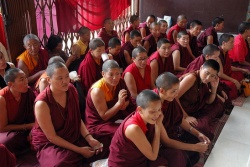Yogâcâryabhûmi
The Yogācārabhūmi-śāstra (Sanskrit) or Discourse on the Stages of Yogic Practice is the encyclopaedic and definitive text of the Yogacara school of Buddhism. It is thought to have been composed in the Sanskrit language in India between 300 and 350 CE.
The complete work comprises five major sections based on seventeen levels (bāhubhūmi) which cover the entire range of mental and spiritual levels in Mahayana Buddhism.
The Compendium of Definitions (viniścaya-samgraha) which discusses and explicates aspects of the bāhubhūmi portion
The Compendium of Exegesis (vivarana-samgraha), a manual of hermeneutical and exegetical techniques.
The Compendium of Synonyms (paryāya-samgraha) defining many of the various strings of quasi-synonymical expressions found in the Āgamas.
The Compendium of Topics (vastu-samgraha) summarizing and explaining the key topics of each sūtra contained in the Samyukta-āgama.
The Compendium of the Vinaya (vinaya-samgraha).
The Chinese version also contains a Compendium of Abhidharma, missing from the Tibetan translation.
Most of the bāhubhūmi section which includes such seminal works as the Bodhisattva-bhūmi and the Śrāvaka-bhūmi survives in Sanskrit, but little survives from the other parts.
Chinese translation
By the end of the Sui dynasty (589-618), Buddhism within China had developed many distinct schools and traditions. In the words of Dan Lusthaus:
Xuanzang came to the conclusion that the many disputes and interpretational conflicts permeating Chinese Buddhism were the result of the unavailability of crucial texts in Chinese translation. In particular, he Xuanzang thought that a complete version of the Yogācārabhūmi-śāstra, an encyclopedic description of the stages of the Yogācāra path to Buddhahood written by Asaṅga, would resolve all the conflicts. In the sixth century an Indian missionary named Paramārtha (another major translator) had made a partial translation of it. Xuanzang resolved to procure the full text in India and introduce it to China.
The leader of Nalanda, Śīlabhadra taught this shastra to Xuanzang and other audiences three times in nine or fifteen months. The Xuanzang version consists of one hundred fascicles (juan), and was translated into Chinese between 646-648 CE at Hongfu Monastery (Chinese: 弘福寺) and Dacien Monastery (Chinese: 大慈恩寺).
Before Xuanzang's version, Dharmakṣema, Guṇabhadra (394-468) and Paramartha had translated part of it.
Tibetan translation
The Tibetan version was done by team of Indian scholars including Jinamitra, Prajñāvarma and Surendrabodhi together with the renowned Tibetan translator, Yéshé Dé (Wylie: ye shes sde) lotsawa. In East Asia, authorship is attributed to Maitreya-nātha, while the Tibetan tradition considers it to have been composed by Asanga, but in all probability it is the work of several writers who compiled it during the 4th century CE.
Nan Huai-Chin touches on the Yogacarabhumi-sastra in his book.

